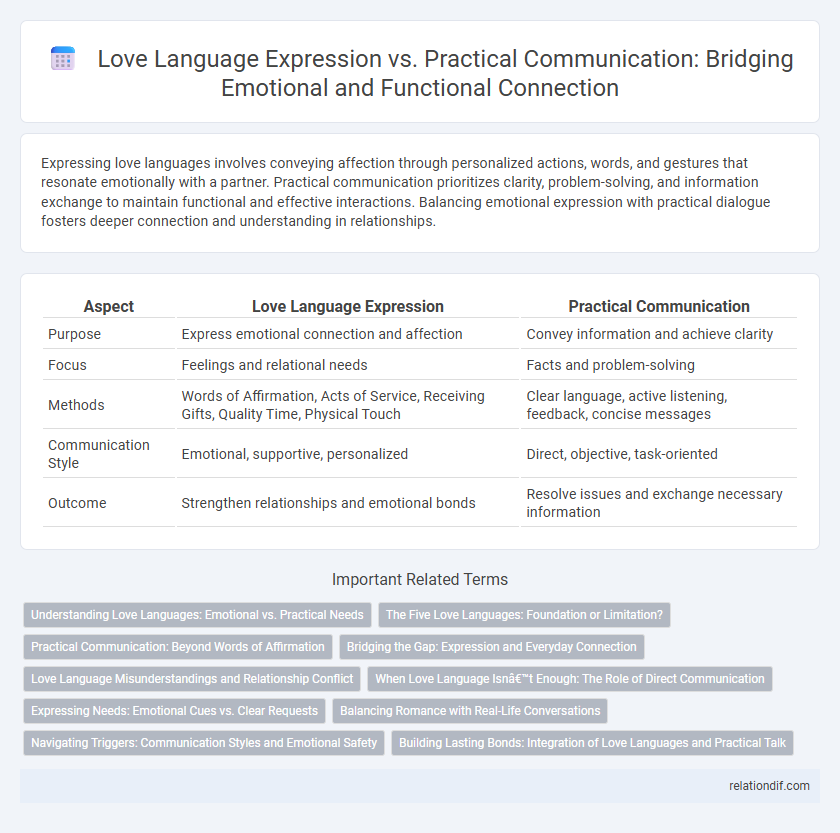Expressing love languages involves conveying affection through personalized actions, words, and gestures that resonate emotionally with a partner. Practical communication prioritizes clarity, problem-solving, and information exchange to maintain functional and effective interactions. Balancing emotional expression with practical dialogue fosters deeper connection and understanding in relationships.
Table of Comparison
| Aspect | Love Language Expression | Practical Communication |
|---|---|---|
| Purpose | Express emotional connection and affection | Convey information and achieve clarity |
| Focus | Feelings and relational needs | Facts and problem-solving |
| Methods | Words of Affirmation, Acts of Service, Receiving Gifts, Quality Time, Physical Touch | Clear language, active listening, feedback, concise messages |
| Communication Style | Emotional, supportive, personalized | Direct, objective, task-oriented |
| Outcome | Strengthen relationships and emotional bonds | Resolve issues and exchange necessary information |
Understanding Love Languages: Emotional vs. Practical Needs
Understanding love languages reveals how emotional expressions like words of affirmation, acts of service, and physical touch fulfill deeper emotional needs, while practical communication addresses everyday problem-solving and shared responsibilities. Recognizing whether a partner values emotional reassurance or actionable support enhances relationship satisfaction and reduces misunderstandings. Effective communication balances expressing affection through personalized love languages with clear, practical dialogue to meet both emotional and logistical needs.
The Five Love Languages: Foundation or Limitation?
The Five Love Languages framework offers a foundational model for understanding how individuals express and receive affection, categorizing expressions into words of affirmation, acts of service, receiving gifts, quality time, and physical touch. While practical communication extends beyond emotional expression to include conflict resolution, information exchange, and daily interaction, relying solely on the Five Love Languages may limit the depth of interpersonal understanding by overlooking complex communication cues and situational context. Integrating love language awareness with broader communication skills enhances relational dynamics and promotes more effective, nuanced exchanges.
Practical Communication: Beyond Words of Affirmation
Practical communication in relationships emphasizes actions and behaviors that demonstrate care and support beyond verbal expressions like words of affirmation. This includes consistent gestures such as assisting with daily tasks, active listening, and problem-solving collaboratively, which build trust and understanding. Prioritizing these tangible forms of communication strengthens emotional connection by reflecting genuine commitment through deeds rather than solely relying on spoken affection.
Bridging the Gap: Expression and Everyday Connection
Love language expression reveals emotional needs through words, gestures, and quality time, while practical communication addresses everyday logistics and problem-solving. Bridging the gap involves integrating empathy and clarity, ensuring that expressions of affection align with straightforward conversations. Effective communication balances emotional connection with practical dialogue, fostering deeper understanding and stronger relationships.
Love Language Misunderstandings and Relationship Conflict
Love language expression often leads to misunderstandings when partners prioritize different modes of emotional communication, causing disconnects in intent and perception. Practical communication emphasizes clarity and explicit messaging, yet may overlook the emotional nuances conveyed through love languages like acts of service or quality time. This tension between expressive and pragmatic communication styles frequently sparks relationship conflict, underscoring the necessity for mutual awareness and adaptation to each partner's preferred love language.
When Love Language Isn’t Enough: The Role of Direct Communication
Love language expression conveys affection through symbolic actions and gestures, but direct communication provides clarity in addressing needs and resolving conflicts effectively. Research shows that couples who combine love languages with explicit verbal communication report higher relationship satisfaction and reduced misunderstandings. Integrating clear dialogue with love language expressions fosters emotional intimacy and practical problem-solving simultaneously.
Expressing Needs: Emotional Cues vs. Clear Requests
Expressing needs through emotional cues often relies on subtle body language, tone, and facial expressions that convey feelings indirectly, which can lead to misunderstandings if not interpreted correctly. Clear requests in practical communication use explicit language to specify desires or requirements, enhancing clarity and reducing ambiguity in conversations. Balancing these approaches allows individuals to connect emotionally while ensuring their needs are understood and met efficiently.
Balancing Romance with Real-Life Conversations
Balancing love language expression with practical communication requires integrating emotional affirmations, such as words of affirmation and acts of service, into everyday dialogues to nurture intimacy and clarity. Effective partnerships thrive when romantic gestures complement direct discussions about responsibilities, expectations, and conflict resolution. Prioritizing both expressive affection and transparent communication fosters deeper understanding and sustainable relational harmony.
Navigating Triggers: Communication Styles and Emotional Safety
Navigating triggers in communication requires understanding diverse love language expressions alongside practical communication techniques to foster emotional safety. Recognizing how words of affirmation, acts of service, or physical touch impact emotional responses helps mitigate misunderstandings and defuse conflicts. Prioritizing empathetic listening and clear boundaries enhances relational trust and supports healthy emotional regulation.
Building Lasting Bonds: Integration of Love Languages and Practical Talk
Combining love languages with practical communication strengthens emotional connection and clarity, fostering deeper understanding between partners. Expressing affection through personalized love languages complements direct, solution-oriented conversations to address everyday challenges effectively. This integrated approach cultivates trust and resilience, essential for building lasting, meaningful relationships.
love language expression vs practical communication Infographic

 relationdif.com
relationdif.com